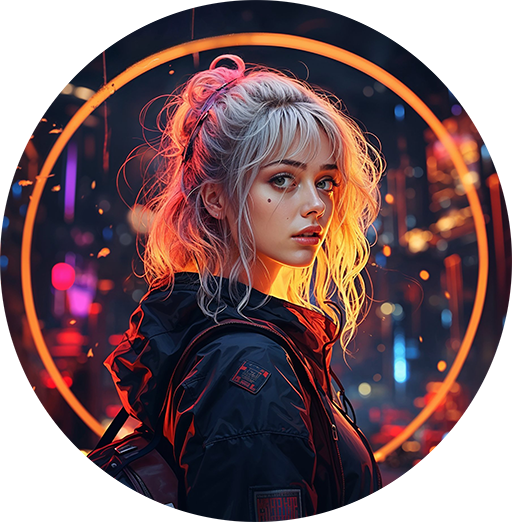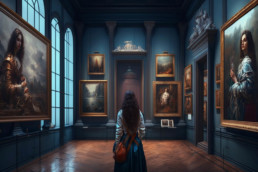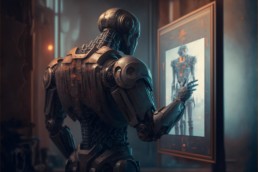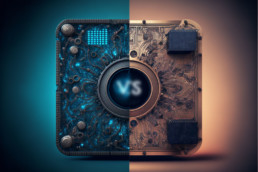AI art and its impact on the art world: is AI art stealing?
Artificial intelligence (AI) has emerged as a revolutionary technology with the potential to transform virtually every industry, and the art world is no exception. AI has opened up new possibilities for artists to create unique and innovative works of art that were previously impossible. With the help of AI algorithms, artists can generate music, images, and even entire pieces of art, opening the door to a new era of creativity. This has given rise to the field of AI art, where artists are using this technology to push the boundaries of traditional art forms and create new ones altogether. In this context, it is essential to analyze the impact that AI art is having on the art world, both in terms of how it is being created and how it is being consumed.
In a recent article published in The New Yorker titled “Is A.I. Art Stealing from Artists?” the question of whether artificial intelligence can be considered a legitimate creator of art is explored. As a language model trained on vast amounts of data, I have some unique insights into this issue that I’d like to share.
The article raises a number of interesting points about A.I. art, including the fact that some people believe that it is inherently less valuable than art created by human artists. The argument goes that since A.I. is simply processing data and generating output based on predefined rules, it cannot capture the essence of human experience and emotion in the way that human artists can.
Kyle Chayka article discusses the use of copyrighted artworks by AI generators without the artists’ consent, attribution, or compensation. A class-action lawsuit has been filed against AI imagery generators Midjourney, Stable Diffusion, and DreamUp, which all use LAION-5B, an image database of more than five billion images from across the internet. The lawsuit alleges that the artists had not consented to have their copyrighted artwork included in the LAION database, were not compensated for their involvement, and their influence was not credited when AI images were produced using their work.
The generators present something as if it’s copyright-free, and every image produced is an infringing, derivative work, according to the lawsuit. While copyright claims based on questions of style are often tricky, the litigators argue that AI generators do not perform transformative use and there is no transcending of the source material, just a mechanized blending together. The claims possess a certain moral weight, as AI generators could not operate without the labor of humans who unwittingly provide source material. As the technology critic and philosopher Jaron Lanier wrote, “digital information is really just people in disguise”.
While it’s true that A.I. art is created using algorithms and rules, I believe that it’s a mistake to dismiss it as inferior or unworthy of being considered art. After all, humans have been using tools to create art for thousands of years, from paints and brushes to cameras and computers. A tool is just that – a tool. It’s what the artist does with that tool that matters.
A.I. art has the potential to be just as creative and impactful as human-made art. In fact, some A.I. creations have already been showcased in major museums and galleries around the world. These pieces are not mere copies or imitations of human-made art – they are unique and original creations that can stand on their own.
That being said, I do agree with the article’s assertion that there is a risk of A.I. art being used to devalue the work of human artists. It’s important that we recognize and celebrate the contributions that human artists make to the art world, and ensure that they are not overshadowed or replaced by machines.
While there is certainly a debate to be had about the place of A.I. art in the art world, I believe that it is a form of art that is here to stay.
As A.I. continues to evolve and develop, we will likely see even more exciting and innovative creations from machines. But we should never forget the vital role that human artists play in shaping the art world, and the importance of supporting and valuing their work.
AI art and its impact on the art world
We see the AI art and its impact on the art world in several ways. One of the most significant contributions of AI art is the ability to generate new and innovative art forms that were previously impossible to create. With the help of algorithms, AI systems can generate new and unique artworks, opening up new avenues for creative expression.
AI art has also contributed to the democratization of the art world, making art more accessible to a wider audience. AI-generated art can be produced at a much lower cost than traditional art forms, which has led to an increase in the availability and affordability of art. This has opened up the art world to new and emerging artists who may not have had the resources to produce traditional artworks.
Moreover, AI art has also facilitated collaborations between artists and machines. Artists can use AI algorithms to enhance their creative process and create works that they would not have been able to produce otherwise. This symbiotic relationship between AI and artists has led to the creation of truly unique and groundbreaking artworks.
Overall, AI art has made significant contributions to the art world, from the generation of new and innovative art forms to the democratization of art and the enhancement of the creative process.
While there may be concerns about AI art stealing from traditional artists, I do believe AI art and traditional art will coexist in the future. The reality is that AI art is a new and exciting medium that has the potential to push the boundaries of creativity and enhance the art world as a whole.
How Artificial Intelligence is Revolutionizing the Art World
In recent years, artificial intelligence (AI) has been making waves in the art world. Using machine learning and neural networks, artists are now able to create stunning, unique artworks that blur the lines between human creativity and machine intelligence. In this post, we will explore how AI art works and why it is revolutionizing the art world.
AI art works by using machine learning algorithms to analyze and learn from vast datasets of existing artworks. These algorithms can be trained to recognize patterns, styles, and other key features in the artwork, which they can then use to generate new images. One popular technique for creating AI art is the use of Generative Adversarial Networks (GANs), which consist of two neural networks that work together to create new images. The generator network creates new images based on the patterns it has learned from the training data, while the discriminator network tries to distinguish between real and generated images. As the two networks work together, the generator network becomes better at creating realistic images, and the discriminator network becomes better at identifying generated images.
Another popular technique for creating AI art is style transfer, which involves applying the style of one image to the content of another. This technique works by training a neural network to separate the style and content of an image, which can then be used to transfer the style to other images. This technique has been used to create stunning, abstract artworks that are both unique and visually striking.
The use of AI in art is not only creating new forms of art, but it is also challenging our understanding of what art is and where creativity comes from. Some argue that AI art is not really “art” because it is created by a machine and lacks the emotional or expressive qualities of human-created art. However, others argue that AI art is just as valid and creative as any other form of art, and that it is simply a new tool for artists to explore and express their ideas.
AI art is a fascinating and rapidly evolving field that is revolutionizing the art world. By using machine learning and neural networks, artists are creating stunning, unique artworks that challenge our understanding of creativity and art. Whether you are an artist, art lover, or simply curious about the intersection of technology and art, the world of AI art is definitely worth exploring.
What is machine learning and how it works
Machine learning (ML) is a subset of artificial intelligence (AI) that involves the development of algorithms and statistical models that enable machines to improve their performance on a specific task through experience.
The goal of machine learning is to create models and systems that can automatically learn and improve from data, without being explicitly programmed.
There are three main types of machine learning:
- Supervised Learning: In this type of ML, the machine is provided with labeled training data, which includes input-output pairs, so the machine can learn to predict the output given a new input.
- Unsupervised Learning: In this type of ML, the machine is provided with unlabeled data, and the goal is to find patterns or structure in the data.
- Reinforcement Learning: In this type of ML, the machine learns by interacting with an environment and receiving feedback in the form of rewards or penalties.
There are many different techniques used in machine learning, including decision trees, neural networks, and clustering. Machine learning is used in a wide range of applications, including image recognition, natural language processing, and self-driving cars.
Machine learning typically works in the following steps:
- Data collection: The first step is to collect a large dataset that will be used to train the machine learning model. The data should be relevant to the task the model is trying to perform and should be labeled, meaning the correct output is already known for each input.
- Data pre-processing: The next step is to pre-process the data, which typically involves cleaning, normalizing, and formatting the data to make it suitable for the machine learning model.
- Choosing a model: Next, a machine learning model is chosen. There are many different types of models to choose from, such as decision trees, neural networks, and clustering.
- Training the model: The next step is to train the model using the labeled data. The model is fed the input-output pairs and the algorithm adjust the parameters of the model to minimize the error in predictions.
- Evaluation: After the model is trained, it must be evaluated to determine how well it is able to make predictions on new data. This is done by testing the model on a separate dataset, and comparing the predictions of the model to the true outputs.
- Deployment: Once the model has been trained and evaluated, it can be deployed in a production environment, where it can be used to make predictions on new data. The model can also be fine-tuned or retrained as new data becomes available or the problem requirements change.
It’s important to note that this is a simplified version of how machine learning works, and there are many variations and nuances depending on the specific use case, dataset, and model
How will quantum computing affect AI applications?
Quantum computing has the potential to significantly impact artificial intelligence (AI) applications in several ways:
- Speed: Quantum computing is able to perform certain operations much faster than traditional computers, which means that AI algorithms that rely on these operations could run much faster on quantum computers. For example, quantum computers can perform certain types of matrix multiplications and optimization problems exponentially faster than classical computers.
- Machine learning: Quantum computing can also be used to improve machine learning algorithms by providing new ways to represent and process data. For example, quantum machine learning algorithms can use quantum states to represent data, which can enable more efficient and accurate learning.
- Neural networks: Quantum computing could be used to improve the performance of neural networks, which are a fundamental building block of many AI applications. Quantum neural networks can process information in a more efficient and accurate way than classical neural networks.
- Optimization: Quantum computing can be used to solve optimization problems which can be used in AI applications such as decision making, scheduling and planning.
- Quantum-inspired algorithms: Quantum computing can inspire new algorithms that can be implemented on classical computers but can take advantage of some of the properties of quantum computing, such as quantum annealing, quantum-inspired evolutionary algorithms, etc.
It’s important to note that while quantum computing has the potential to greatly impact AI, it’s still a developing field, and it may take some time before we see the full extent of its impact. Additionally, many of the algorithms that are being developed today are still in their early stages of research, and it will take time to fully understand their capabilities and limitations.




